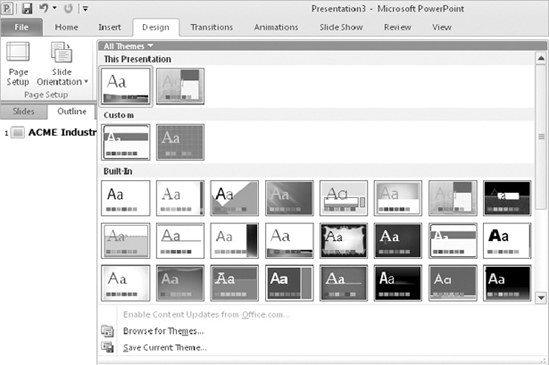A theme includes a
background graphic (usually), color and font choices, and graphic effect
settings. A theme can also include custom layouts. The method for
applying a theme depends on whether that theme is already available in
the current presentation or not. Some themes are built into PowerPoint
so that they are always available; other themes are available only when
you use certain templates, or when you specifically apply them from an
external file. The following sections explain each of those
possibilities.
NOTE
Themes, also called design themes,
contain a combination of colors, fonts, effects, backgrounds, and
layouts. There are also more specialized themes: color themes, font
themes, and effect themes.

1. Applying a Theme from the Gallery
A gallery
in PowerPoint is a menu of samples from which you can choose. The
Themes gallery is a menu of all of the built-in themes plus any
additional themes available from the current template or presentation
file.
To select a theme from the gallery, follow these steps:
(Optional) If you want to affect only certain slides, select them. (Slide Sorter view works well for this.)
On
the Design tab, in the Themes group, if the theme you want appears,
click it, and skip the rest of these steps. If the theme you want does
not appear, you will need to open the gallery. To do so, click the down
arrow with the line over it, as shown in Figure 2.

The Themes gallery opens, as shown in Figure 3.
The gallery is divided into sections based upon the source of the
theme. Themes stored in the current presentation appear at the top;
custom themes you have added appear next. Built-in themes appear at the
bottom.

|
You can drag the
bottom-right corner of the menu to resize the gallery. To filter the
gallery so that only a certain category of theme appears, click the down
arrow to the right of All Themes at the top and select a category from
the menu that appears.
|
|
Click the theme you want to apply.
If you selected multiple slides in step 1, the theme is applied only to them.
If you selected a single slide in step 1, the theme is applied to the entire presentation.
|
To override the default
behavior in step 3, so that you can apply a different theme to a single
slide, right-click instead of clicking in step 3 and choose Apply to
Selected Slide(s) from the shortcut menu.
|
|
2. Applying a Theme from a Theme or Template File
You can open and use
externally saved theme files in any Office application. This makes it
possible to share color, font, and other settings between applications
to create consistency between documents of various types. You can also
save and load themes from templates.
To apply a theme to the presentation from a theme or template file, follow these steps:
On the Design tab, open the Themes gallery (see Figure 3) and click Browse for Themes. The Choose Theme or Themed Document dialog box opens.
Navigate to the folder containing the file and select it.
NOTE
Any custom themes you might have previously saved are located by default in C:\Users\username\AppData\Roaming\Microsoft\Templates\Document Themes (in Windows Vista or Windows 7) or C:\Documents and Settings\username\Application
Data\Microsoft\Templates\Document Themes (in Windows XP). However, you
don't need to navigate to that location to open a theme file because all
themes stored here are automatically included in the gallery already.